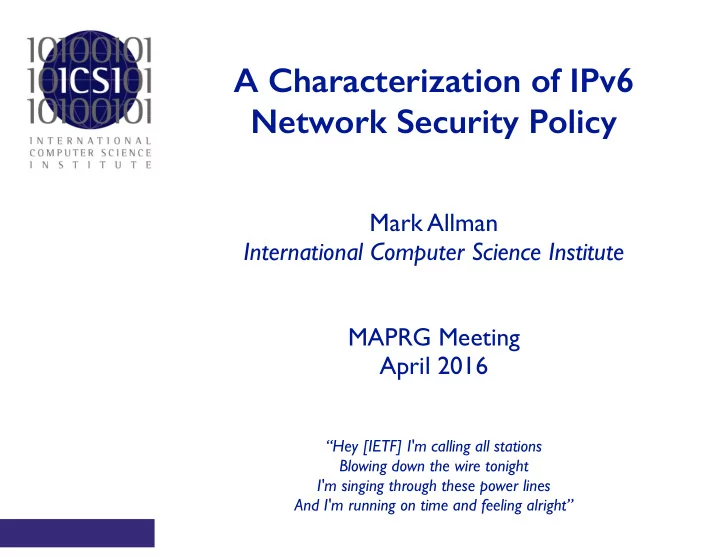

A Characterization of IPv6 Network Security Policy Mark Allman International Computer Science Institute MAPRG Meeting April 2016 “Hey [IETF] I'm calling all stations Blowing down the wire tonight I'm singing through these power lines And I'm running on time and feeling alright”
Acknowledgments • Collaborators: • Jakub (Jake) Czyz, U. Mich. • Matthew Luckie, CAIDA/U. Waikato • Michael Bailey, UIUC � • Paper: • Jakub Czyz, Matthew Luckie, Mark Allman, Michael Bailey. Don’t Forget to Lock the Back Door! A Characterization of IPv6 Network Security Policy . Network and Distributed System Security Symposium, February 2016. http://www.icir.org/mallman/pubs/CLAB16/ Allman 2
State of IPv6 IPv6 gaining traction Allman 3
IPv6 Security • IPv6 is not inherently more or less secure than IPv4 � • IPv6 ecosystem is actually less secure • Lack of maturity in stacks, processes, tools, operator competency • In dual-stack world, IPv6 is a second attack path Allman 4
IPv6 Security “In new IPv6 deployments it has been common to see IPv6 traffic enabled but none of the typical access control mechanisms enabled for IPv6 device access.” � — Chittimaneni, et al., Internet-Draft draft-ietf-opsec-v6 Allman 5
Overview • We know policy discrepancies can happen � • We know via anecdote that policy discrepancies do happen � • We want to know the extent to which policy discrepancies do happen in the wild Allman 6
Methodology 1. Derive a list of dual-stack devices 2. Probe devices via IPv4 & IPv6 3. Determine fate of probes vs. network protocol utilized Allman 7
Finding Dual-Stack Hosts • Glib version: • Obtain lists of devices (names or IP addresses) • Leverage DNS to provide connective tissue between IPv4 & IPv6 addresses • Calibration phase to enhance confidence in connective tissue � • Full details of methodology in the paper Allman 8
Dual-Stack Devices • Device lists: • 25K dual-stack routers • 520K dual-stack servers � • Note: we verified that all identified dual-stack hosts speak both IPv4 and IPv6 Allman 9
Probing Router Server • Probe each host via ✓ ✓ ICMP Echo ✓ FTP IPv4 and IPv6 ✓ ✓ SSH ✓ ✓ • Use scamper to Telnet ✓ ✓ HTTP send: ✓ BGP ✓ ✓ HTTPS • basic probes ✓ SMB ✓ MySQL • traceroute -style ✓ RDP probes ✓ ✓ DNS ✓ ✓ NTP ✓ ✓ SNMPv2 Allman 10
Judgment • Crucial assumption: probes with different network protocols and different fates indicate a policy difference � • E.g., an unsuccessful IPv4 probe and a successful IPv6 probe indicates a policy difference � • Small scale independent validation, stay tuned Allman 11
Router Results Allman 12
Router Results Allman 12
Server Openness Allman 13
Intra-Network Uniformity • Want to know how uniform policies are within networks � • For each routed prefix and each application: • calculate the fraction of hosts with the most popular policy (v4-only, v6-only or both) Allman 14
Intra-Network Uniformity Policy settings are generally systematic within network boundaries. Allman 15
Policy Enforcement • How: • Passive : probe is silently discarded • Active : probe triggers an error (TCP RST, ICMP unreachable, etc.) • Where: • Target : destination of probe • Other : some hop on path prior to destination Allman 16
Policy Enforcement • IPv6 uses more active blocking than IPv4 • Target host responsible for more blocking in IPv4 Allman 17
Policy Enforcement • IPv6 uses more active blocking • Policy enforcement equally shared between target and other Allman 18
Notification & Validation • Wanted to know if our findings were … • … correct? • … intentional? Allman 19
Notification & Validation • 16 operators contacted, 12 responded • All confirmed our results • All indicated different policy was unintentional Allman 20
Final Bits • Unintentionally open services are a symptom of a less mature IPv6 ecosystem • So, be diligent beyond ACLs � • Our test modules are available as part of scamper • So, test your own networks/devices Allman 21
Questions? Comments? � � � � � � � Mark Allman, mallman@icir.org http://www.icir.org/mallman/ @mallman_icsi
References • NDSS paper: http://www.icir.org/mallman/pubs/CLAB16/ � • Google’s IPv6 Statistics: https://www.google.com/intl/en/ipv6/statistics.html • SIGCOMM paper on IPv6 adoption: http://www.icir.org/mallman/pubs/CAZ+14/ Allman 23
Recommend
More recommend